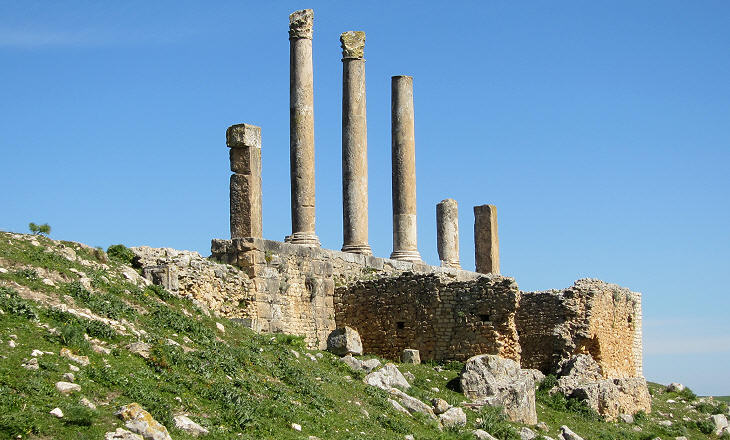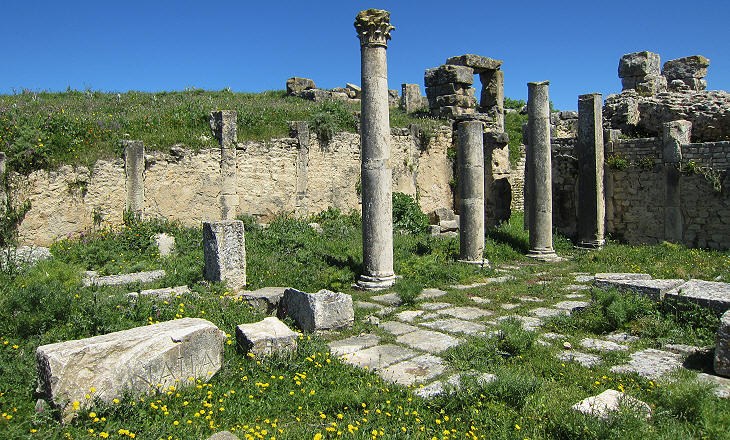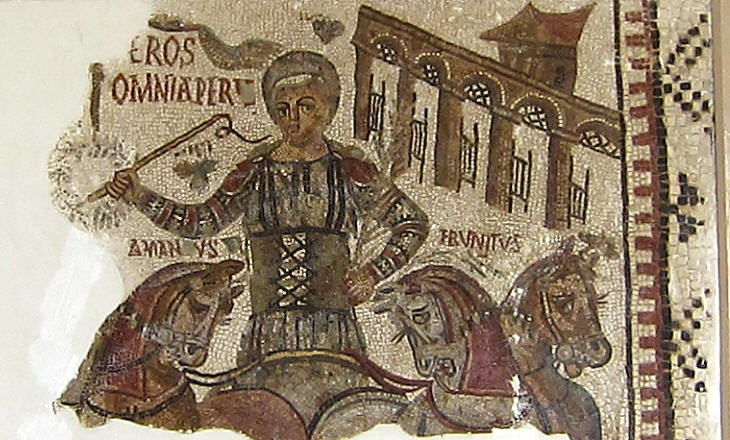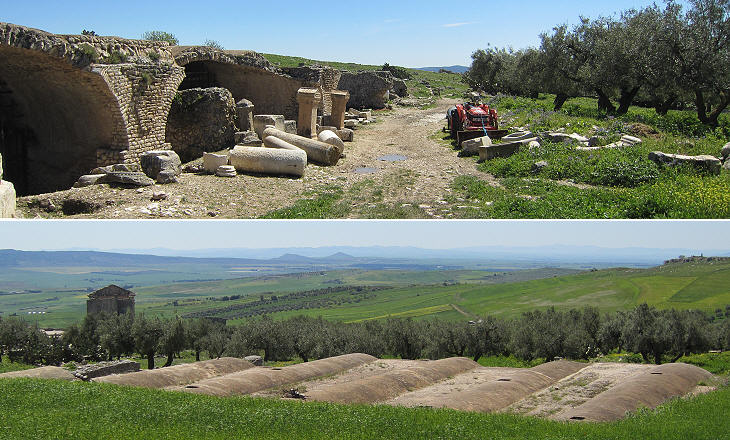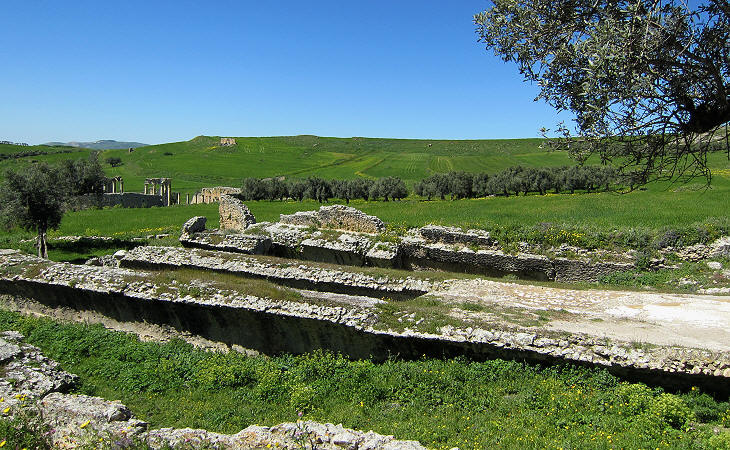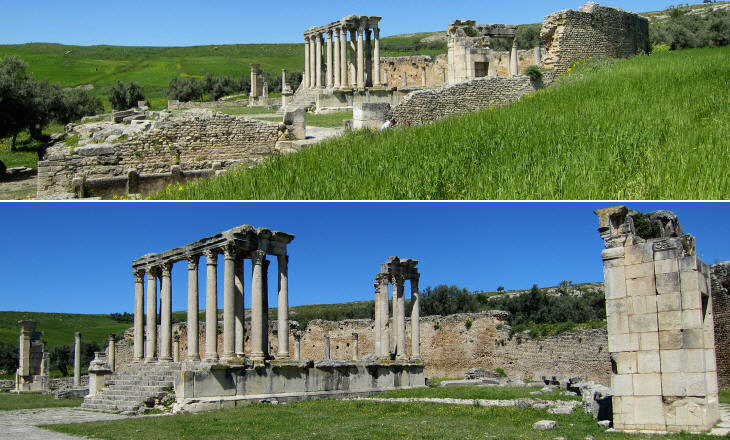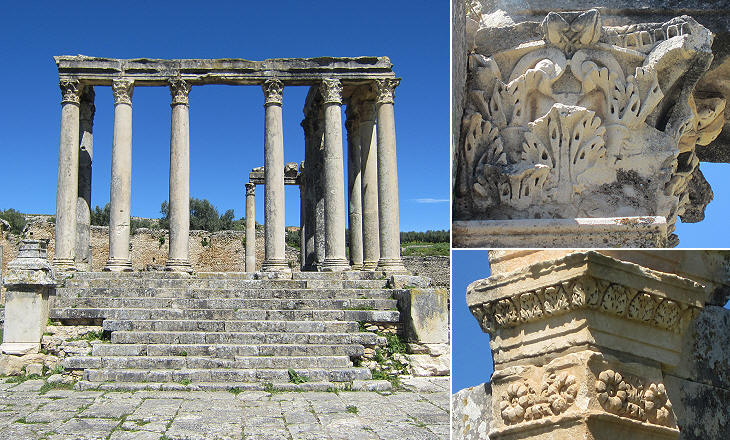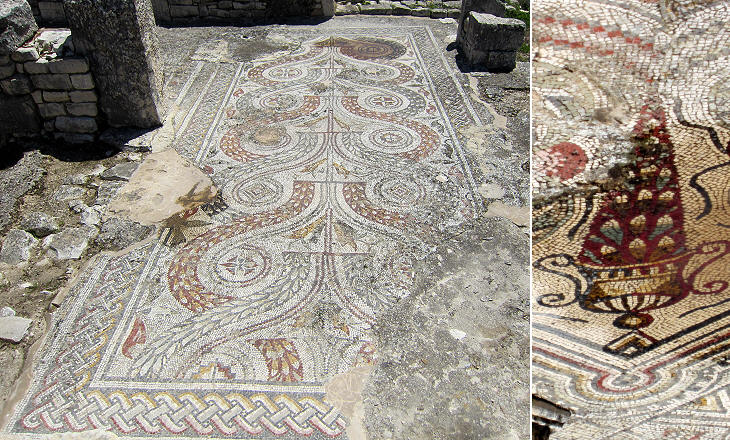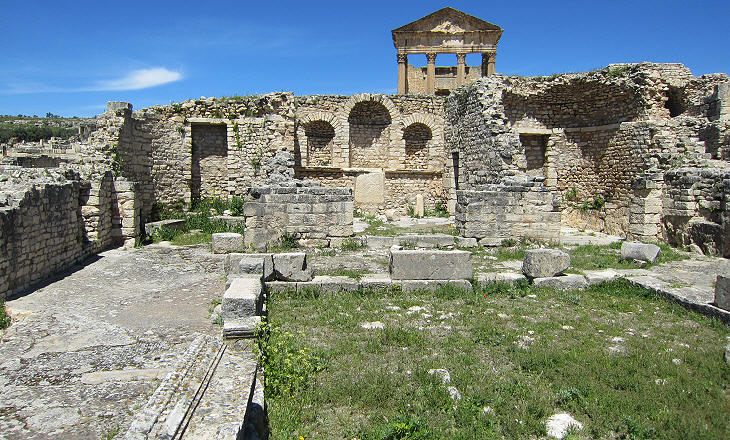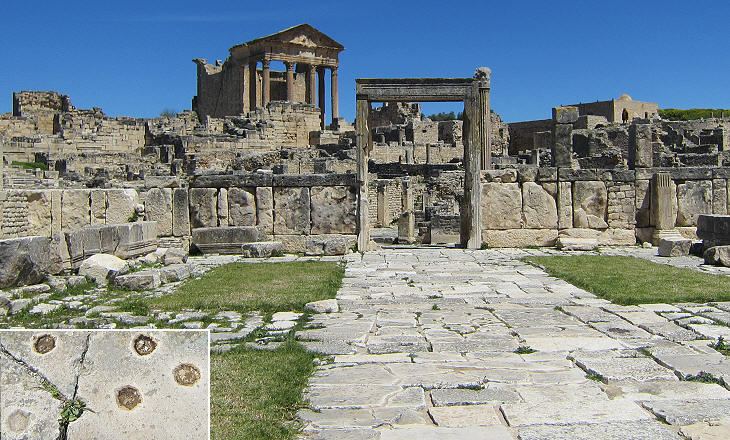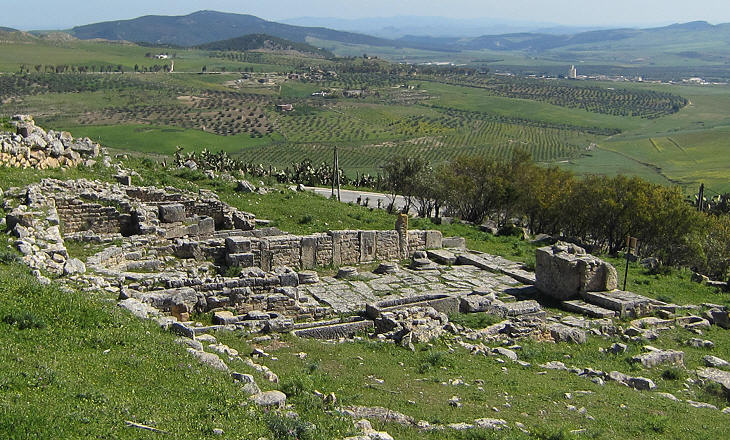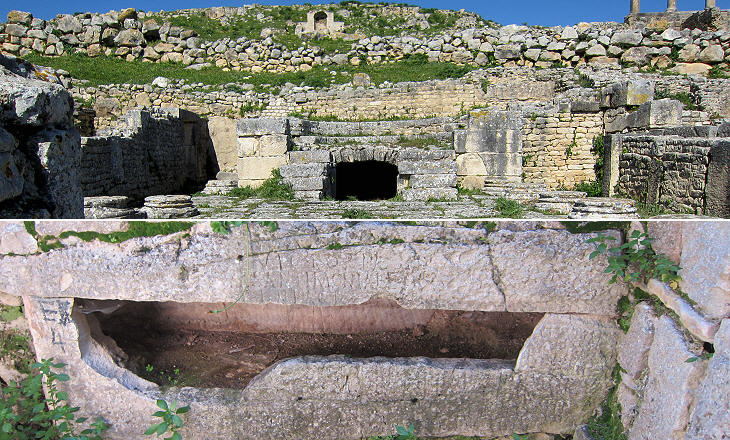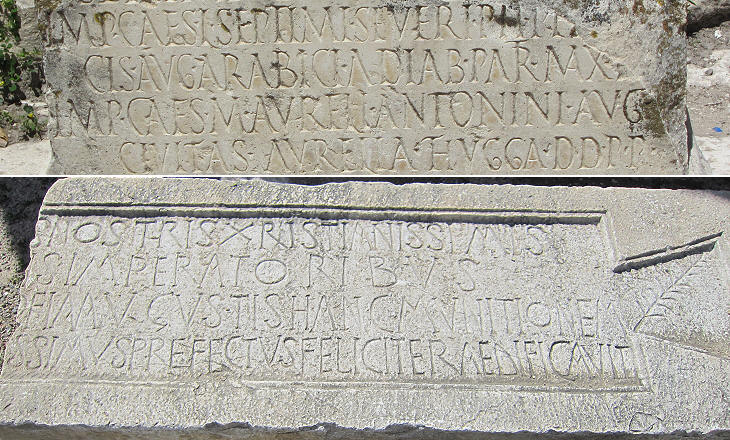  What's New! Detailed Sitemap All images © by Roberto Piperno, owner of the domain. Write to romapip@quipo.it. Text edited by Rosamie Moore. Page added in July 2012. |
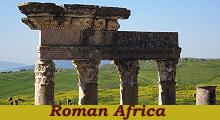 - Thugga (Dougga) II: north-western quarters - Thugga (Dougga) II: north-western quarters(detail of the theatre at Thugga) Page one provides a historical introduction to Thugga and a description of the monuments located at its centre, most of which were built during the reigns of Emperors Hadrian, Antoninus Pius and Marcus Aurelius (117-180 AD). This page illustrates the development of the town to the north and the west during the Severian Dynasty (193-235).
At Thugga, Thuburbo Majus and at other ancient towns in Tunisia archaeologists have identified large temples dedicated to Saturn which were located in a commanding, but rather remote position. The inhabitants of Thugga were not of Phoenician origin, but their contacts with Carthage led them to adopt Ba'al and his wife Tanit, the main Punic deities, as their own. After the Roman conquest Ba'al was renamed Saturnus and Tanit Juno Caelestis. The Temple to Saturn was built in 195 AD on a previous shrine at the top of the hill above Thugga (archaeologists have found a large number of ex-votos referable to that shrine). The construction of the new temple required substantial terracing and in the dedicatory inscription, Lucius Octavius Victor Roscianus, the donor, said the temple cost him 150,000 sesterces. For the Romans Saturn was an Italian god-king who presided over a mythical golden age and Saturnalia were one of the main festivities of the Roman calendar (you may wish to see the Temple to Saturn in the Roman Forum).
A terrace below the Temple to Saturn was outside the pomerium (legal boundary) of Thugga and therefore the construction of funerary monuments was allowed. Archaeologists have identified five necropolises in the olive groves which surround Thugga today; in general they do not retain major monuments with the exception of a large family tomb which was used for several centuries. At the beginning it contained urns with the ashes of the dead because cremation was the usual way of disposing of corpses. During the Late Empire sarcophagi were introduced, but at Thugga they do not appear to have been decorated with reliefs as elsewhere.
The top of the hill retains some ruins of pre-Roman walls and outside them large stones which marked the site of some Numidian tombs. In this location which is quite remote from the town a temple was built by Iulia Paula Laenatiana at the time of Emperor Antoninus Pius. She had the highly honorific title of Imperial flamen, i.e. she was in charge of promoting popular devotion to the emperors. The dedication to Minerva can be explained by the fact that the goddess was one of three deities honoured in the most important temple of Rome on the Capitol Hill. A few years later a temple (Capitolium) was dedicated to the three deities in the Forum of Thugga.
Archaeologists have identified the site of a circus near the Temple to Minerva which was built in 225 exploiting a natural depression of the ground. The dedicatory inscription says its construction was postulante universo populo requested by all the inhabitants of the town. A mosaic found at Thugga gives an idea of how popular chariot races were in the town. It is similar to a modern baseball player poster. The hero is Eros, a chariot driver who has won a race (as he holds a palm branch) and who is acclaimed by his supporters (Omnia per te - we are all for you). Two of his horses have names (Amandus/Lovable and Frunitus/Jovial). In the background the mosaic depicts, the carceres, the cages from which the chariots started the race (you may wish to see those at Villa dei Sette Bassi near Rome). Archaeologists however do not think the mosaic depicts the actual circus of Thugga, because it was too small to have five chariots racing on the same line.
The economy of ancient Thugga was based on farming and the same applies to Nouvelle Dougga, the village where those who lived among the ancient monuments were resettled in the 1960s. In order to provide Thugga and the surrounding fields with water the Romans captured it at some nearby springs and stored it in a series of long cisterns, which today are used as warehouses.
The Gabinii were a very wealthy family of Thugga. They often held the office of Imperial flamen (priest) and they promoted the construction of several monuments. During the reign of Emperor Alexander Severus they built a large shrine dedicated to Juno Caelestis to the west of the town which required the construction of a road. At the junction between this road and that which came from the valley to the south of Thugga they built a triumphal arch dedicated to the emperor. Another arch stood at the eastern entrance to the town. Thugga was a few miles away from the Roman road which linked Carthage to Theveste (in today's Algeria) where Legio III Augusta was stationed.
Other cisterns can be seen immediately outside the arch. They were the terminal point of an eight mile long aqueduct built at the time of Emperor Commodus, most likely to supply the Southern Baths.
The Temple to Caelestis was built in a large crescent shaped temenos (enclosure) which housed a holy grove. The shape of the enclosure is thought to be a reference to Tanit, the Punic goddess whose symbol was a crescent (you may wish to see it on a stela at Sicca Veneria). Today the temple has a commanding view over the valley, but it is more likely that the enclosure included a long wall opposite the temple, in order to completely hide ceremonies from the eyes of those who did not attend them.
The temple was built on a very high podium (frequently seen in Roman temples). The space between the two central columns is wider than the others, something which rarely occurred in temples consistent with Greek standards. Ceremonies took place in the cella, but more often they consisted of processions along the portico which surrounded the temple. The decoration of the temple was particularly elaborate; while the capitals of the main temple do not depart from tradition, those of ancillary buildings were decorated with roses (which appear also in the Arch of Alexander Severus) or with an unusual type of Corinthian capital.
Gabinia Hermona, a member of the same family that funded the construction of the Temple to Caelestis, built a temple celebrating Emperor Caracalla's victories. As a matter of fact Caracalla had the titles of Britannicus, Germanicus and Parthicus because he accompanied his father Septimius Severus on campaigns in Britain, Germany and Mesopotamia. When he undertook a campaign against the Parthians on his own, results were inconclusive and the emperor was assassinated at Carrhae.
The finest mosaics found at Thugga during the early excavations were moved to the Museum of Bardo in Tunis. Those having a purely decorative purpose without representation of human beings or animals were left in situ where they gradually disappeared. The mosaics found in more recent periods were left in place, but owing to the lack of a Museum at Thugga, they are at risk of disappearing too.
The temple to Tellus is one of the last additions to the monuments of Thugga. It was built in 261 at the time of Emperor Gallienus. His reign was marked by great difficulties, but apparently these did not impact on Thugga because a house with very elaborate mosaics was built in that period. Tellus (Earth) was a Roman goddess protecting agriculture; this temple is one of the few dedicated to her in the Provinces. She is portrayed in a famous relief of Ara Pacis Augustae in Rome.
A large rectangular portico which had at its centre a lost building is still named after the house of an Arab inhabitant of the town. It was built at the same time as the Capitolium. The standing portal is popular with visitors because it allows framed views of that temple.
Unlike almost all the other ancient Roman towns of the region, Thugga has very few Christian monuments. Archaeologists found evidence that at some point the Temple to Caracalla was turned into a church, but the only meaningful memory of Christian Thugga is a small necropolis near the Temple to Saturn. It housed a church in part excavated into the hill, with several underground tombs and built with materials taken from the nearby temple. It is dated early Vth century when the Province of Africa had not yet been invaded by the Vandals.
The church is named after an inscription on a sarcophagus: santimoniali means that Victoria devoted herself to God, so she was a sort of nun. It does not say how many years she lived, which is rather strange because even the shortest funerary inscriptions had this piece of information. The inscription was carved in a very rough way.
Move to page one: Introduction and central part of the town or page three: south-eastern quarters Move to: Introductory Page Bulla Regia Carthago Mactaris Musti Neapolis Sicca Veneria Simitthus Sufetula Thuburbo Majus Thysdrus Uthina Utica Ziqua Mosaics in the Museum of Bardo  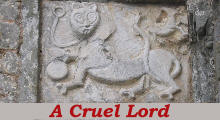 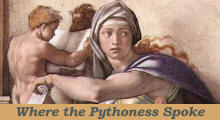 
|
